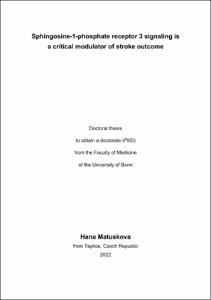Matuskova, Hana: Sphingosine-1-phosphate receptor 3 signaling is a critical modulator of stroke outcome. - Bonn, 2022. - Dissertation, Rheinische Friedrich-Wilhelms-Universität Bonn.
Online-Ausgabe in bonndoc: https://nbn-resolving.org/urn:nbn:de:hbz:5-67632
Online-Ausgabe in bonndoc: https://nbn-resolving.org/urn:nbn:de:hbz:5-67632
@phdthesis{handle:20.500.11811/10185,
urn: https://nbn-resolving.org/urn:nbn:de:hbz:5-67632,
author = {{Hana Matuskova}},
title = {Sphingosine-1-phosphate receptor 3 signaling is a critical modulator of stroke outcome},
school = {Rheinische Friedrich-Wilhelms-Universität Bonn},
year = 2022,
month = aug,
note = {Stroke is a leading cause of long-term disability worldwide. Its highly complex pathogenesis is characterized by a deleterious cycle of vascular dysfunction and inflammation. Recently, the bioactive phospholipid sphingosine-1-phosphate (S1P), has gained increasing attention in cardiovascular diseases due to its involvement in both vascular function and immune cell responses. Altered S1P levels have been reported in several cardiovascular and inflammation-associated diseases, including stroke. S1P signals via five ubiquitously expressed S1P receptors, S1Pr1-5. Previous in vitro studies revealed alterations of S1Pr3 signaling under inflammatory conditions. During vascular adaptation to disease models of middle cerebral artery occlusion (MCAo), we determined the expression pattern of S1Pr3 in brain tissue with qPCR and western blot. Transient MCAo in endothelial- and astrocyte-specific RiboTag transgenic mice allowed us to determine changes in S1P signaling through immunoprecipitation of translating mRNAs from both cell types. For modulation of S1Pr3 signaling, we used S1Pr3-/- mice or pharmacological S1Pr3 inhibition administered 4 and 8 hours after permanent MCAo. Stroke outcome was determined by infarct size evaluation, neuroscore, and assessment of cerebral blood flow (CBF) using magnetic resonance imaging.
S1Pr3 expression was significantly increased 1 day and 3 days post-ischemia in the ipsilateral hemisphere of WT mice on the gene and protein level. Mice lacking S1Pr3 revealed improved neurological function and reduced ischemic lesion during the acute phase after experimental stroke. Using vessel-parenchyma fractionation of brain tissue, we detected the majority of S1Pr3 associated with cerebral vessels. RiboTag analysis unveiled an augmentation of astrocyte- but not endothelial-specific S1Pr3 expression 1 day and 3 days post-stroke. RiboTag results were further confirmed using in situ hybridization colocalization of Gfap and Sox9, astrocytic markers and S1Pr3 in the ischemic hemisphere. Single administration of an S1Pr3 antagonist 4 hours after permanent MCAo led to significant CBF improvements in the ipsilateral hemisphere 1 day post-stroke that persisted up to 3 days. Consequently, infarct size was significantly reduced in mice treated with S1Pr3 antagonist. However, later administration at 8 hours post-stroke did not improve CBF or reduced infarct size.
In conclusion, our findings point to an important involvement of the S1P/S1Pr3 signaling axis during stroke, and a potential contribution of astrocytes-specific S1Pr3 signaling during the acute phase post-stroke. Modulating S1Pr3-mediated vascular responses may emerge as a viable target to improving stroke outcome.},
url = {https://hdl.handle.net/20.500.11811/10185}
}
urn: https://nbn-resolving.org/urn:nbn:de:hbz:5-67632,
author = {{Hana Matuskova}},
title = {Sphingosine-1-phosphate receptor 3 signaling is a critical modulator of stroke outcome},
school = {Rheinische Friedrich-Wilhelms-Universität Bonn},
year = 2022,
month = aug,
note = {Stroke is a leading cause of long-term disability worldwide. Its highly complex pathogenesis is characterized by a deleterious cycle of vascular dysfunction and inflammation. Recently, the bioactive phospholipid sphingosine-1-phosphate (S1P), has gained increasing attention in cardiovascular diseases due to its involvement in both vascular function and immune cell responses. Altered S1P levels have been reported in several cardiovascular and inflammation-associated diseases, including stroke. S1P signals via five ubiquitously expressed S1P receptors, S1Pr1-5. Previous in vitro studies revealed alterations of S1Pr3 signaling under inflammatory conditions. During vascular adaptation to disease models of middle cerebral artery occlusion (MCAo), we determined the expression pattern of S1Pr3 in brain tissue with qPCR and western blot. Transient MCAo in endothelial- and astrocyte-specific RiboTag transgenic mice allowed us to determine changes in S1P signaling through immunoprecipitation of translating mRNAs from both cell types. For modulation of S1Pr3 signaling, we used S1Pr3-/- mice or pharmacological S1Pr3 inhibition administered 4 and 8 hours after permanent MCAo. Stroke outcome was determined by infarct size evaluation, neuroscore, and assessment of cerebral blood flow (CBF) using magnetic resonance imaging.
S1Pr3 expression was significantly increased 1 day and 3 days post-ischemia in the ipsilateral hemisphere of WT mice on the gene and protein level. Mice lacking S1Pr3 revealed improved neurological function and reduced ischemic lesion during the acute phase after experimental stroke. Using vessel-parenchyma fractionation of brain tissue, we detected the majority of S1Pr3 associated with cerebral vessels. RiboTag analysis unveiled an augmentation of astrocyte- but not endothelial-specific S1Pr3 expression 1 day and 3 days post-stroke. RiboTag results were further confirmed using in situ hybridization colocalization of Gfap and Sox9, astrocytic markers and S1Pr3 in the ischemic hemisphere. Single administration of an S1Pr3 antagonist 4 hours after permanent MCAo led to significant CBF improvements in the ipsilateral hemisphere 1 day post-stroke that persisted up to 3 days. Consequently, infarct size was significantly reduced in mice treated with S1Pr3 antagonist. However, later administration at 8 hours post-stroke did not improve CBF or reduced infarct size.
In conclusion, our findings point to an important involvement of the S1P/S1Pr3 signaling axis during stroke, and a potential contribution of astrocytes-specific S1Pr3 signaling during the acute phase post-stroke. Modulating S1Pr3-mediated vascular responses may emerge as a viable target to improving stroke outcome.},
url = {https://hdl.handle.net/20.500.11811/10185}
}






